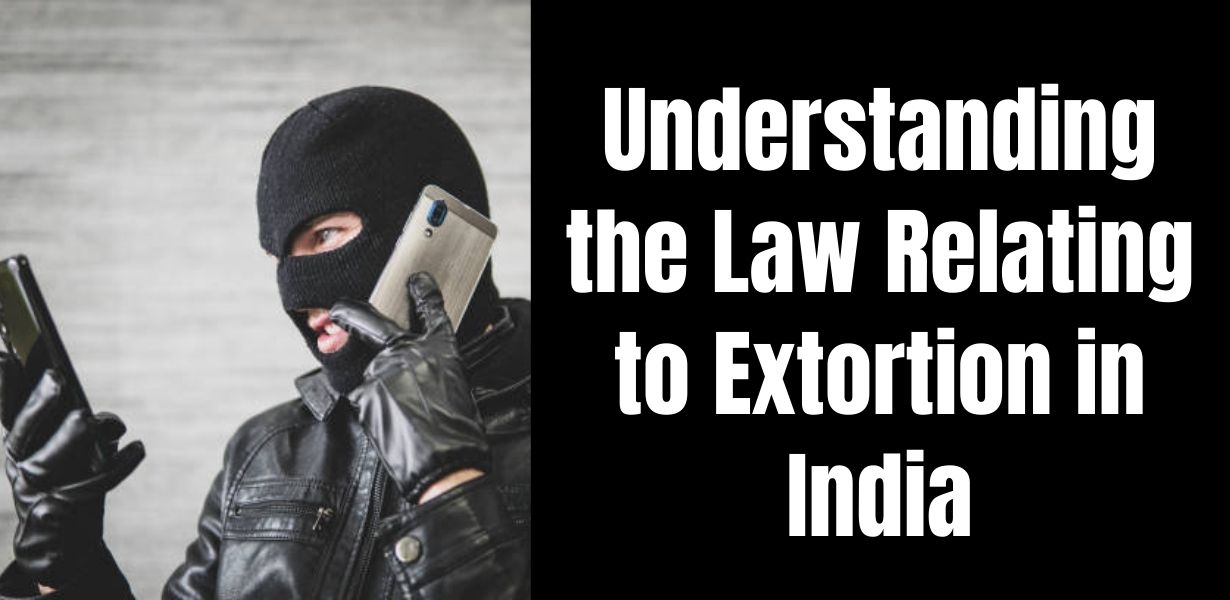Understanding the Law Relating to Extortion in India

Extortion is a serious criminal offence under the Indian Penal Code. It is defined as the act of intentionally putting any person in fear of injury or harm, with the aim of dishonestly inducing that person to deliver any property, valuable security or anything that can be converted into a valuable security to another person.
The laws related to extortion are entailed in sections 383-389 of the Indian Penal Code.
In order to convict a person for the offence of extortion, a few ingredients have to be satisfied. The presence of a fear of threat or injury, the existence of a dishonest intention, and the transfer of property or valuable security under the fear of threat or injury are some of the key ingredients.
Section 384 of the IPC contains the penalty for extortion, whereas Section 385 entails the punishment for an attempt to commit extortion.
It is important to note that extortion usually involves the wrongful use of actual or threatened force, violence, or intimidation to obtain money or property from a person or entity. This article will delve deeper into the laws relating to extortion in India, including the various provisions of the Indian Penal Code that deal with this crime.
Page Contents
The Law Relating to Extortion in India (IPC)
Definition of Extortion
383 Extortion —Whoever intentionally puts any person in fear of any injury to that person, or to any other, and thereby dishonestly induces the person so put in fear to deliver to any person any property or valuable security, or anything signed or sealed which may be converted into a valuable security, commits “extortion”.
Illustrations
Some illustrations of extortion include:
(a) A threatens to publish a defamatory libel concerning Z unless Z gives him money. He thus induces Z to give him money. A has committed extortion.
(b) A threatens Z that he will keep Z’s child in wrongful confinement, unless Z will sign and deliver to A a promissory note binding Z to pay certain monies to A. Z signs and delivers the note. A has committed extortion.
(c) A threatens to send club-men to plough up Z’s field unless Z will sign and deliver to B a bond binding Z under a penalty to deliver certain produce to B, and thereby induces Z to sign and deliver the bond. A has committed extortion.
(d) A, by putting Z in fear of grievous hurt, dishonestly induces Z to sign or affix his seal to a blank paper and deliver it to A. Z signs and delivers the paper to A. Here, as the paper so signed may be converted into a valuable security. A has committed extortion.
Punishment for Extortion

The punishment for Extortion under Section 384 of the IPC is imprisonment for a term which may extend to three years, or with fine, or with both.
Punishment for Attempt to Extortion
Under Section 385 of the IPC,
385. Putting person in fear of injury in order to commit extortion – Whoever, in order to the committing of extortion, puts any person in fear, or attempts to put any person in fear, of any injury, shall be punished with imprisonment of either description for a term which may extend to two years, or with fine, or with both.
Section 387 in The Indian Penal Code:
387. Putting person in fear of death or of grievous hurt, in order to commit extortion.—Whoever, in order to the committing of extortion, puts or attempts to put any person in fear of death or of grievous hurt to that person or to any other, shall be punished with imprisonment of either description for a term which may extend to seven years, and shall also be liable to fine.
Chapter XVII of the Indian Penal Code
The law relating to Extortion can be found in Chapter XVII of the IPC, which deals with offences against property. This chapter also covers other offences such as theft, possession of stolen property, and robbery.
Bail and Custody
Extortion is a non-bailable offence, which means that the accused cannot be released on bail unless the court grants permission. The victim or complainant can also apply for custody of the accused.
Extortion on the Internet
With the rise of the internet, extortion has also become prevalent on online platforms. Cyber extortion involves the use of threats or force to obtain money or property from a victim. Offenders may use various techniques such as ransomware attacks, DDoS attacks, or phishing scams to extort money from individuals or businesses.
Extortion and Family
Extortion can also occur within families, where one member may use threats or force to obtain money or property from another member. This can lead to domestic violence and other forms of abuse.
Overall, the law relating to extortion in India is strict, and offenders can face severe punishment. It is important for individuals to be aware of their rights and take appropriate legal action if they become victims of extortion.
Essential Elements of Extortion

Extortion is a serious offence under the Indian Penal Code (IPC). The essential elements of extortion are:
Putting a person in fear of hurt or injury
The first element of extortion is the intentional act of putting a person in fear of hurt or injury. The person who commits Extortion must have a malicious or dishonest intention to cause wrongful gain to themselves and wrongful loss to the victim. The fear of hurt or injury can be physical or mental.
Dishonest inducement to the person
The second element of extortion is the dishonest inducement to the person. The person who commits extortion must use deception or dishonesty to induce the victim to deliver property or valuable security. The inducement can be in the form of a threat, promise, or any other means of deception.
Delivery of property | Valuable security
The third element of extortion is the actual delivery of property or valuable security. The delivery must be made by the victim to the person who committed extortion. The property or valuable security can be in any form, including documents that can be converted into valuable security.
To bring home an offence under Section 384 Indian Penal Code, the prosecution has to prove the following:
(i) The accused put the victim in fear of some Injury as defined under Penal Code.
(ii) That such injury was to either the victim or to some other person.
(iii) That the accused made such situation; put in fear intentionally
(iv) Accused induced the other person to deliver to some person some property immovable or movable or any valuable security.
(v) It was done by the accused, intending to make either any wrongful gain to himself or any wrongful loss to some other.
Extortion is a crime that can result in severe punishment. Anyone who commits extortion can face imprisonment for up to three years and a fine. It is essential to understand the elements of extortion to avoid being a victim or the culprit.
The age, sex and situation of the person threatened may properly be taken into consideration. To constitute the offence it seems necessary that the person threatened should be actually put In fear; upon the whole of facts, if there is reason enough to say that similar circumstances would ordinarily excite fear in persons of the same age, etc., as the person threatened, the Court will come to the conclusion that the offence of extortion is committed.
Difference between Theft and Extortion

Theft and extortion are two different types of criminal offences that are often confused with each other. While both involve taking something that does not belong to the perpetrator, there are some key differences between the two.
Definition
Theft is defined as the act of taking someone else’s property without their consent. This can include physical objects like money, jewelry, or electronics, as well as intangible things like intellectual property or trade secrets. Extortion, on the other hand, involves using threats or coercion to force someone to give up something of value, whether it be money, property, or services.
Consent
In theft, the property is taken without the owner’s consent. In contrast, extortion involves obtaining wrongful consent. The perpetrator of extortion may use threats of violence or harm to coerce the victim into giving up their property or services.
Use of Force
Theft does not necessarily involve the use of force, while extortion often does. The perpetrator of extortion may threaten the victim with physical harm, damage to their property, or other consequences if they do not comply with their demands.
Punishment
The punishment for theft and extortion can vary depending on the severity of the crime and the jurisdiction in which it occurs. In India, the punishment for extortion under Section 386 of the Indian Penal Code is rigorous imprisonment of up to 10 years or a fine. The punishment for theft under Section 379 of the Indian Penal Code is imprisonment of up to 3 years or a fine, or both.
| THEFT | EXTORTION |
| In theft, the property is taken away without the owner’s consent. | In extortion, the consent of the owner is obtained, but unlawfully. |
| There is no element of force in theft. | Element of force is necessary for extortion. |
| Theft is only in respect of the movable property. | Property may be movable or immovable. |
| Property must be moved by a person who is committing the crime. | Delivery of property or valuables must be made. |
| While committing the offence of theft there is no delivery of the property | It includes the delivery of property in case of Extortion |
While both theft and extortion involve taking something that does not belong to the wrong doer, they are distinct criminal offences with different elements and punishments. It is important to understand the differences between the two in order to accurately identify and prosecute these crimes.
Case Laws | Landmark Judgements
A. R Antulay v. R. S Nayak AIR (1986) SC
In this case, the Supreme Court of India held that the public servant who misuses his position and extorts money from others is guilty of criminal misconduct. The Court observed that the act of extortion by a public servant is a serious offence that not only affects the individual but also undermines the integrity of the public institution. The court also held that the evidence of the victim is sufficient to establish the offence of extortion.
Romesh Chandra Arora v. State (1960)
In this case, the Supreme Court of India held that the offence of extortion is complete as soon as the accused intentionally puts the victim in fear of injury or annoyance to the person or property. The court held that it is not necessary that the victim should actually be put in fear or that the accused should have obtained any property from the victim.
Shankar Bhagvat (1866)
In this case, the Bombay High Court held that the offence of extortion is committed when a person intentionally puts another person in fear of injury to his person or property, and thereby dishonestly induces the person so put in fear to deliver any property or valuable security.
Compounding of the Offence
The offences under Section 384 and 506 Part II of the Penal Code are not compoundable under section 320 of the Code of Criminal Procedure, 1973. Therefore, the prayer of compounding the offence is made by the complainant cannot be legally accepted. [Karipi Rashid v. State of AP 2009]
What is Sextortion?
Sextortion is a form of cybercrime in which an individual or group attempts to blackmail or extort money, goods, or other favors from someone by threatening to expose or distribute explicit or intimate materials involving the victim. The term “sextortion” is a combination of “sex” and “extortion.”
Typically, the process begins when the wrong doers access to explicit photos, videos, or other sensitive materials of the victim. This can happen through various means, such as hacking into personal devices, social engineering, or even through voluntary sharing that is later exploited. The perpetrator then uses these materials as leverage to coerce the victim into complying with their demands.
The threats made by the extortionist may involve exposing the explicit content to the victim’s family, friends, colleagues, or the public, posting it online, or distributing it widely. They may also demand money, gift cards, or other forms of payment in exchange for not carrying out their threats.
Also Check:
Conclusion
The punishment for extortion varies depending on the severity of the offence and can range from imprisonment up to ten years and a fine. It is a cognizable and non-bailable offence that can be tried by a Magistrate.
While both offences involve taking someone’s property, extortion involves the use of fear or force to obtain the property, whereas theft does not.
Overall, the criminal law relating to extortion in India is designed to protect individuals from being victimized by criminals. By understanding the law and taking steps to prevent extortion, individuals can help to ensure their safety and security.







